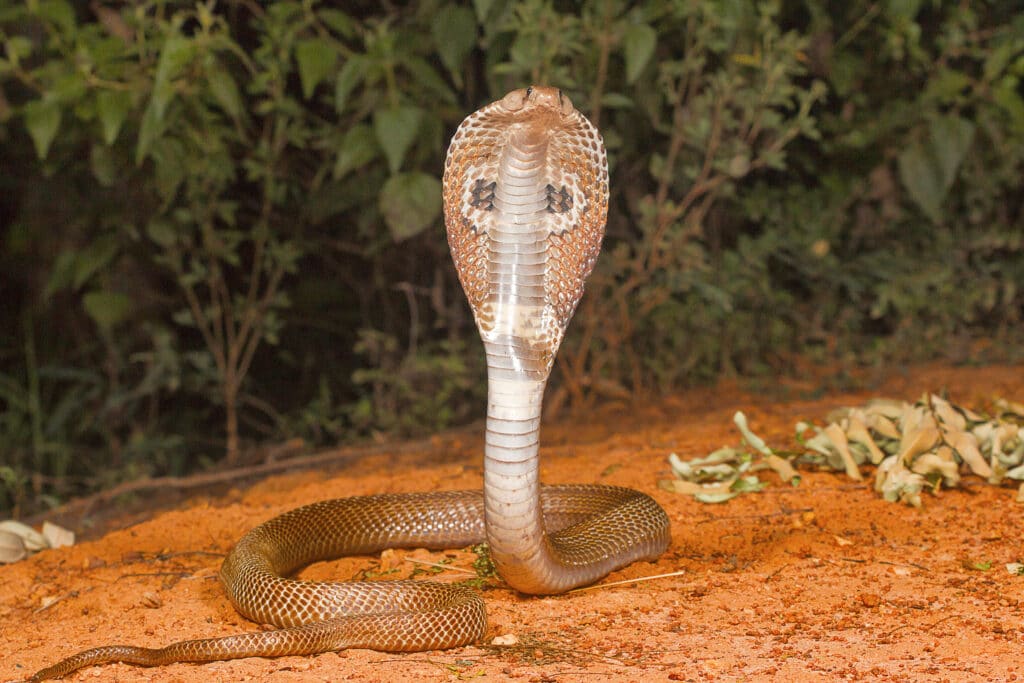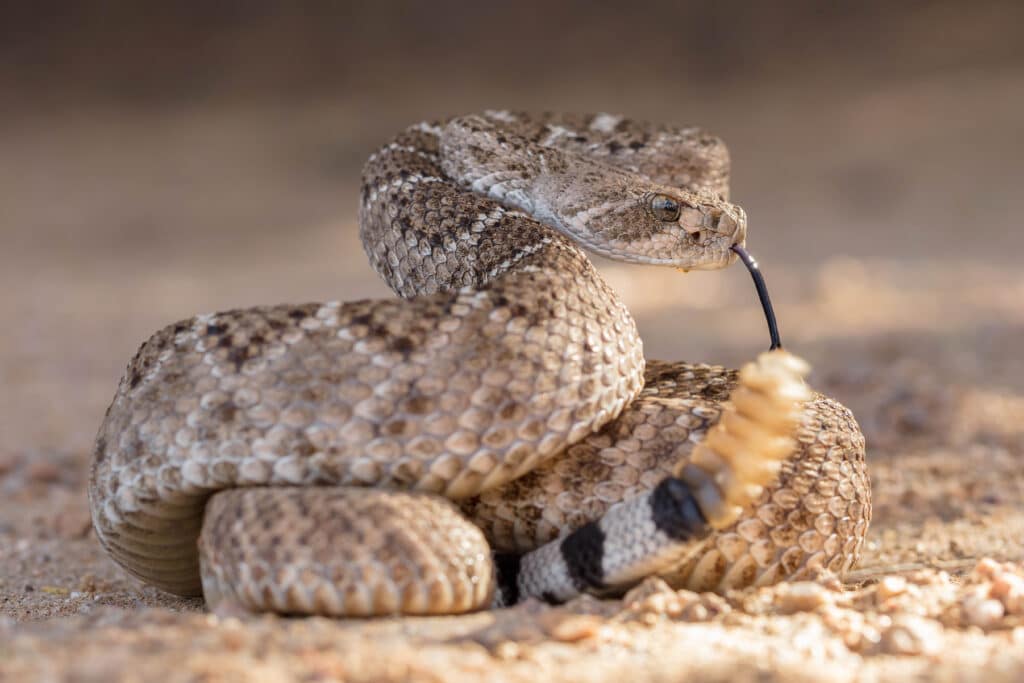Most users we know choose to get high on relatively conventional drugs – be it cannabis, psychedelics, cocaine, alcohol, meth, opiates, and so on. Not all of those are good/safe options for recreational use, but they’re all drugs that most people have some familiarity with. Then we have a small portion of our population that manages to find some pretty off-the-wall ways to get high.
A new report presents cases of people getting high from snake venom. But how exactly does it work? And how to users survive the bite from a venomous snake without medical treatment? Let’s take a closer look.
The Snake Venom High
Curiosity about snake venom intoxication and possible addiction peaked after a 2018 study that followed a man who regularly subjected himself to cobra bites to experience a high. The study was published in the Indian Journal of Psychological Medicine, and presented the case of a 33-year-old man with a long history of drug abuse. According to him, he had been abusing alcohol, tobacco, and opiates since he was 18 years old.
For years he used various forms of opiate drugs, and also unsuccessfully attempted to quit many times. A few months before the researchers found him, he started using snake venom to get high after hearing about its powerful effects from some of his friends. According to the man, professional snake handlers would guide an Indian cobra (N. naja) to bite him on the tip of his tongue, at which point he would experience side effects such as blurred vision, nausea, unresponsiveness, and spasticity for the first couple hours.
After that, the “fun” begins. The man stated he would feel happy, relaxed, sleepy, and euphoric (similar to what he felt on opioids but intensified), and the effects would last around 3 to 4 weeks. He claimed that “this state of pleasure was stronger than anything he had experienced while taking alcohol or opioids.”
There are some obvious issues with letting a venomous snake bite your face for a high. First and foremost, you could die, and not in the run-of-the-mill, overdosed on drugs kind of way. With this method, you could die before you even get to feel the slightest bit of the high. The study subject also experienced standard withdrawal symptoms when the snake venom wore off, however, and then he would relapse on opioids.

Another problem is dosing. The dose of snake venom this man or other case studies in the report received is unknown. And because they let the snake bite them to get the venom, and snakes can control, or meter, how much venom they inject, it’s nearly impossible to measure how much the users received with any consistency.
Eventually, the man was detoxed from snake venom with the help of medication-assisted treatment and inpatient drug treatment. And while it did take months, that’s much less than the years it took him trying to get clean from opioids and alcohol.
How do they not die?
The question that’s probably burning in everyone’s mind right now, is how can someone get bitten by a venomous snake, refuse medical treatment, and still survive with seemingly no long-term repercussions to their health? Are some people immune to certain snake venoms? Or is this an immunity that can be developed after numerous bites?
While the accepted answer to both of these questions is “no”, we know that in life, there are outliers. A perfect example is Bill Haast, a scientist-turned-snake handler from the United States, who reportedly was bitten by venomous snakes at least 173 times over the course 60 years. Haast was in the business of venom extraction for medical research, with the intention of developing new medications and vaccines.
Another man with similar claims is Tim Friede, who also says he took about 100 bites from different species of venomous snakes and developed an immunity. “What I do is called venom immunotherapy,” Mr Friede said. “I take diluted injections of venom protein over time to build up my immune system. What that does is build up good antibodies through time that bind to the venom and neutralize it so I don’t die. This is the same way they make anti-venom in horses, I just cut the horse out of the picture. I’ve become the horse.”
And these aren’t just baseless claims, although there is very little in the way of solid data regarding either of the above two men. But there is some research to back up the idea of snake venom immunity. Researchers from Australia have discovered that African and Asian primates have acquired resistance to cobra venoms. The research shows that the last common ancestor of humans, chimpanzees and gorillas, were also immune to snake venom.

“As primates from Africa gained the ability to walk upright and dispersed throughout Asia, they developed weapons to defend themselves against venomous snakes, this likely sparked an evolutionary arms race and evolving this venom resistance,” said Richard Harris, a PhD candidate at the University of Queensland.
The scientists also believe that sensory improvement that has occurred in primates can be partially attributed to snakes. For example, they claim that good vision could have developed to avoid snakes as well, noting that primates in areas with few venomous snakes were observed to have poorer eyesight than their counterparts.
And the evidence doesn’t stop there. It’s long been theorized that our immune system can make snake venom symptoms worse, but researchers at Standford University School of Medicine say the exact opposite. According to their study, which was published in the journal Science in July 2006, said that our immune systems actually play a crucial role in neutralizing venom in our bodies.
Led by Stephen Galli, MD, professor and chair of the Department of Pathology, the research team examined the venom of three different venomous snake species, and honeybees. Using lab mice, they found that mast cells in mammals gave us an edge when fighting snake venom symptoms. They concluded that the “net effect of the mast cell response to the four venoms is to enhance resistance to the toxicity and reduce mortality induced by the venom.”
A type of white blood cell that is found in connective tissues all through the body, especially under the skin, near blood vessels and lymph vessels, in nerves, and in the lungs and intestines. They are one our first lines of defense in fighting infection, due to their location and their release of mediator compounds such as histamine, leukotrienes, cytokines chemokines, and neutral proteases. This is how they work against snake bites, by releasing proteins that break down some of the venom’s most toxic components.
What are the therapeutic implications here?
This method of getting high, as rare as it may be, does give rise to some valid questions regarding the medicinal use of snake venom. Snake venom has been used medicinally for thousands of years. Animal venoms in general were the basis for many pharmaceutical preparations used historically for the treatment of smallpox, leprosy, and wounds.

Snake venom contains several neurotoxic, cardiotoxic, cytotoxic, nerve growth factor, lectins, disintrigrins, haemorrhagins and many other different enzymes that even to this day, are being used to develop medications for thrombosis, arthritis, cancer and many other diseases. For instance, Captopril, Integrilin, Alfimeprase, and Aggrastat are drugs based on snake venoms, and all are FDA approved. Can we add opioid addiction to the list of diseases that could be cured with snake venom?
If the cobra venom really does offer users a 3-4 week “high”, think about how many people would turn away from conventional opioids in favor of this? Not just for the high, but for relief from pain and related anxiety and depression. Of course, dosage and addiction potential would have to be taken into account, but based on the above case study, the person using snake venom was able to quit that with much greater ease than opioids and alcohol.
Final thoughts
There really are some crazy ways to get high, but probably none crazier than letting a cobra bite your tongue so you can feel a month-long, opioid type of high. It’s insane to think about, but it goes to show you that some people will try absolutely anything to get their fix. The silver lining here is that, with the knowledge of how long the effects of snake venom last, in addition to their historical therapeutic use, it shows promise in finding new ways to use snake venom in modern medicine. Perhaps next, to fight opioid addiction.
Hello readers. We’re happy to have you with us at Cannadelics.com; a news source here to bring you the best in independent reporting for the growing cannabis and hallucinogen fields. Join us frequently to stay on top of everything, and subscribe to our Cannadelics Weekly Newsletter, for updates straight to your email. Check out some awesome promos for cannabis buds, smoking devices and equipment like vapes, edibles, cannabinoid compounds, amanita mushroom products, and a whole bunch more. Let’s all get stoned together!









